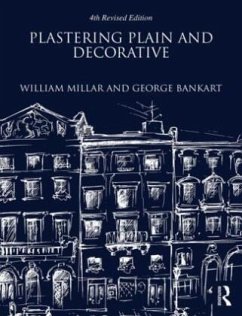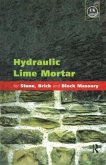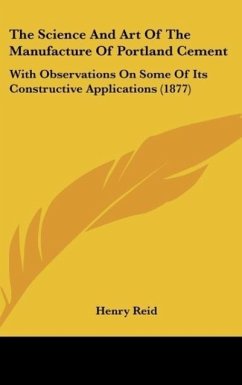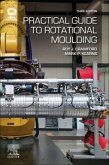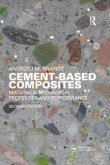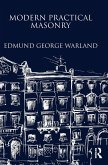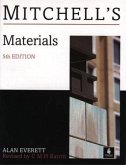- Gebundenes Buch
- Merkliste
- Auf die Merkliste
- Bewerten Bewerten
- Teilen
- Produkt teilen
- Produkterinnerung
- Produkterinnerung
William Millar's classic book "Plastering Plain and Decorative" is universally referred to as the 'Plasterer's Bible'. It was first published in 1897 and was clearly a great success, with a second edition following a couple of years later in 1899 and a third edition in 1905 (a reprint of the first edition is available from Donhead). In 1927 the publishers, B. T. Batsford Ltd, decided that it was time to republish Millar's 'magnus opus', but that the fourth edition should be revised and updated. They asked George P. Bankart, an architect/craftsman and author, who had already written another…mehr
Andere Kunden interessierten sich auch für
![Hydraulic Lime Mortar for Stone, Brick and Block Masonry Hydraulic Lime Mortar for Stone, Brick and Block Masonry]() Geoffrey AllenHydraulic Lime Mortar for Stone, Brick and Block Masonry34,99 €
Geoffrey AllenHydraulic Lime Mortar for Stone, Brick and Block Masonry34,99 €![Materials Technology Materials Technology]() Yvonne DeanMaterials Technology81,99 €
Yvonne DeanMaterials Technology81,99 €![The Science And Art Of The Manufacture Of Portland Cement The Science And Art Of The Manufacture Of Portland Cement]() Henry ReidThe Science And Art Of The Manufacture Of Portland Cement43,99 €
Henry ReidThe Science And Art Of The Manufacture Of Portland Cement43,99 €![Practical Guide to Rotational Moulding Practical Guide to Rotational Moulding]() Roy J CrawfordPractical Guide to Rotational Moulding148,99 €
Roy J CrawfordPractical Guide to Rotational Moulding148,99 €![Cement-Based Composites Cement-Based Composites]() Andrzej M. BrandtCement-Based Composites81,99 €
Andrzej M. BrandtCement-Based Composites81,99 €![Modern Practical Masonry Modern Practical Masonry]() Edmund WarlandModern Practical Masonry195,99 €
Edmund WarlandModern Practical Masonry195,99 €![Materials Materials]() Alan EverettMaterials109,99 €
Alan EverettMaterials109,99 €-
-
-
William Millar's classic book "Plastering Plain and Decorative" is universally referred to as the 'Plasterer's Bible'. It was first published in 1897 and was clearly a great success, with a second edition following a couple of years later in 1899 and a third edition in 1905 (a reprint of the first edition is available from Donhead). In 1927 the publishers, B. T. Batsford Ltd, decided that it was time to republish Millar's 'magnus opus', but that the fourth edition should be revised and updated. They asked George P. Bankart, an architect/craftsman and author, who had already written another book for them, to take on this task. George Percy Bankart was an architect highly influenced by the 'Arts and Crafts' movement, who had chosen to work as a decorative craftsman. The 'Arts and Crafts' was an English movement dedicated to the idea that architecture could be inspired by a revival of traditional building crafts and materials. It started in the second half of the 19th century, based on the writings of Ruskin and was driven by the ideas Morris, amongst many others; and carried on into the first quarter of the 20th century. Bankart was born in Leicester on the 20th January 1866, and was a great friend of Ernest W. Gimson, another Leicester born architect, just over a year his elder. Both men studied and became architects, and shared a creative passion for the handicrafts. Whilst Gimson's career included embroidery design, traditional chair-making and furniture design, as well as decorative modeled plasterwork, Bankart concentrated primarily on plasterwork. Their different activities were true to the ideas of the Arts and Crafts movement, and their designs reflect the movement's interest in a return to nature. Bankart's career as an author started with "The Art of The Plasterer", which was published by B. T. Batsford Ltd in 1909. He seems to have taken a break from writing until, together with his son G. Edward Bankart, he produced two books "Modern Plasterwork Construction" in 1926, followed in 1927 by "Modern Plasterwork Design", both published by the Architectural Press. Also in 1927 he was back with B. T. Batsford Ltd for the publication of this fourth and revised edition of 'Millar'.
Produktdetails
- Produktdetails
- Verlag: Routledge / Taylor & Francis
- Seitenzahl: 496
- Englisch
- Abmessung: 30mm x 189mm x 246mm
- Gewicht: 1080g
- ISBN-13: 9781873394878
- Artikelnr.: 37194936
- Herstellerkennzeichnung Die Herstellerinformationen sind derzeit nicht verfügbar.
- Verlag: Routledge / Taylor & Francis
- Seitenzahl: 496
- Englisch
- Abmessung: 30mm x 189mm x 246mm
- Gewicht: 1080g
- ISBN-13: 9781873394878
- Artikelnr.: 37194936
- Herstellerkennzeichnung Die Herstellerinformationen sind derzeit nicht verfügbar.
Contents Editorial Preface Note of Acknowledgement A Prefatory Note Author's Preface Chapter 1: Plasterwork Generally - A Glimpse of its History, by G. T. Robinson, F.S.A. Prehistoric; in the dawn of history; in early Egypt; amongst the Greeks and their colonies; Roman work from the commencement to the decline of the empire; its oriental development; in the Middle Ages; in the Renaissance; its culmination in the sixteenth century; its decorative growth in France and England; under Francis 1 and Henry VIII; under the Stuart Dynasty; its decline under the Hanoverian Influence; its low condition at the end of last century; its hoped for revival Chapter 2: Eastern and Continental Plasterwork. Saracenic; Persian; Spanish and Moorish; Indian; Chinese; Italian; French; German; Austrian; Belgian; Russian. Chapter 3: Lime-Stucco Plasterwork (Stucco-duro) in Principle and Practice, by G. P. Bankart Chapter 4: Modern Plasterwork, by G. P. Bankart Chapter 5; Modelling and Design in Relief - as Specially Applicable to Plasterers' work, by G. P. Bankart Chapter 6: Tools and Appliances. Plasterers' tools, appliances, and plant; labourers' tools; scaffolding; the worshipful company of Plasterers; the plasterers' craft. Chapter 7: Materials. Plaster of Paris: manufacture, boiled plaster, baked plaster, quick and slow setting plaster, tests, chemical properties, setting qualities, colour, compressive and adhesive strength of French plaster; Limes: hydraulic, lias, chalklimes, rich versus short limes, Scotch limes, Irish limes, calcination, slaking and tests; Mortar: grinding coarse stuff, lime putty, protection of lime putty, setting stuff, haired putty setting, lime water; Hair: ox hair, fibrous and sawdust substitutes for hair: Sand: pit, river and sea sands; Masteric: Scotch and London mastics, mastic mouldings, Hamelein's mastic, mastic cement; stearate of Lime, pythoA" plaster. Chapter 8: Materials (Continued). Cements: Portland cement, super-cement, white, Portland cement, water-proofing cements, slag, Roman, Martin's, Keen's, Parian, Robinson; Selenitic: hydraulic cements and plasters, granite, sirapite; Lathing: expanded metals, Jhilmil, Bostwick, Johnson's, patent metal sheet lathing, patent reed lathing, slate laths, Hy-rib. Chapter 9: of Decorative Ceilings Generally: Solid Work. Panelled, figuredA" and ribbed ceilings; rib brackets and lathing; floating panelled ceilings; setting out panelled ceilings; panel mouldings; coffered ceilings; planted panel mouldings; setting ceilings; lime putty finish; hard finish; fine finish; cement finish; Portland cement ceilings; fibrous plaster ceilings; working plans of panelled ceilings; classic panelling. Chapter 10: Running Diminished and Circular Mouldings. Diminished columns; diminished floating rules; column trammel; constructing diminished plain columns; setting out flutes of diminished columns; constructing diminished fluted columns; forming diminished fluted columns by the rim and collar methods; diminished fluted pilasters; panelled coves; pressed screeds; diminished mouldings; double diminished mouldings; running double diminished mouldings; diminished rule method; top rule method; cupola panels and mouldings; panelled beams; trammel for elliptical mouldings; templates for elliptical mouldings; plasterer's oval; circular mouldings on circular surface; trammel centre. Chapter 11: Exterior Plastering and Sgraffito. Sgraffito or graffitoA"; fresco; buon fresco; fresco secco. Chapter 12: Model and Running Mould Making. To draw a truss; to make a model of a truss; hinged running moulds for diminished models; to make a keystone; to set out and make a Corinthian column capital; to make a pilaster capital; to make composite, Doric and Tuscan capitals; to set out and make Ionic capitals and entablature; to draw the Ionic Volute; centre flowers; cast enrichment mitres and abutments; running moulds; running moulds for enriched cornices; twin slippered mould; arch radius mould; hanging moulds; notes on running moulds. Chapter 13: Moulding and Casting. The plasterer's shop; plaster box; squeezing wax; moulding wax; clay squeezing; clay piece moulds; plaster waste moulding; moulding from life; plaster piece moulding; modillions and blocks; model making of balusters; plaster piece moulding balusters; casting balusters; oiling plaster moulds; solutions for moulding and casting; gauging plaster; plaster casting; hollow casts; strong plaster for casting; casting white cements; casting Portland cement; water-seasoned plaster moulds; casting cement mouldings (waster mould process); pressed cement work. Chapter 14: Gelatine Moulding. Its use for moulding; gelatine manufacturers, tests, insoluble gelatine, preserving, indurating, dissolving; seasoning plaster models; shellac seasoning; oil seasoning; paraffin wax seasoning; seams and blebs in jelly moulds; oiling jelly moulds, gum oil, chalk oil, petroleum oil; to make a plaster case; cases, joggles, to separate cases; gelatine moulding; to jelly mould a truss; to jelly mould a bust; brushed jelly moulds; moulding white models; moulding casts; open jelly moulds; straight moulds; glue mould; rubber varnish, copal varnish, shellac varnish; soft and spotty casts; gelatine casts; preparation of the material; making the mould, making the cast, making a plaster bed for cast, to paint the cast; India-rubber moulds; fibrous plaster and concrete fireproof; to make a fibrous plaster case; casting balcony fronts; casting in large jelly moulds; curved balcony fronts; to mould and cast concavo-convex mouldings; stiffening rules; balcony front; interchangeable moulds; combined gelatine and plaster piece moulds. Chapter 15: Fibrous Plasterwork. Patented and introduced into England; use for fibrous plaster; for renovating old ceilings; fibrous plaster for panelled ceilings; fibrous plaster nomenclature; materials; cutting canvas; fibrous plaster wooden laths; size water; fibrous plaster casting; casting plain fibrous plaster columns and pilasters; casting fibrous plaster centre flowers; undercutting fibrous plaster; fibrous plaster cornices; mitre and join stops; casting fibrous plaster plain cornices; casting fibrous plaster enriched cornices; bedded enrichment system; moulding and casting fibrous enrichments; fixed and cast enrichment systems; fixing fibrous plaster cornices; fibrous plaster measurements; fire-resisting fibrous plaster; expanded metal lathing; fibrous plaster decorative sheets; muslin plaster casts; tow and plaster casts; rapid plastering; fibrous plaster slabs; fibrous plaster slab moulds; fibrous plaster slab making; setting fibrous plaster slabs; Fire-resisting slabs; combination slabs; patent simplex partition blocks; external slabs; 'Mack' patent fire-resisting slabs; reed slabs; grooved slabs; perforated slabs; pugging and deafening slabs; hardening and damp-proofing fibrous plaster slabs; litharge oil; fibrous plaster blocks. Chapter 16: ReverseA" Moulding. Its uses and terms; to set out a reverse template; to make a reverse casting mould for cornices; panel mouldings; rib mouldings; plain capitals; diminished and fluted columns and pilasters; plain columns; hollow cores and column casts. Chapter 17: Compositions. Gesso; woods; Walter Crane's recipe; ceiling in gesso; gesso duro; how to begin to lay pictures; method of making and manipulating; how to fasten linen on panels; laying grounds; preparing a fine ground; preparing a ground for Gesso Sottile; to smooth the surface of a panel; planning Gesso Sottile surfaces; Smith's Patent Metal. Chapter 18: Compositions (continued). Papier-mache; manufacture and uses for decorations; stage properties; papier-mache moulds; paper casts without moulds; to make paste; permanent paste; Carton-pierre; recipes; English and French Carton-pierre; fibrous slab or patent wood; pate coulante; paste composition; making sulphur moulds for composition; recipes; London composition; sulphur moulds; casting and fixing composition. Chapter 19: Plasterers' Memoranda, Quantities, Weights and Recipes. Quantities of plastic materials required for various works; concrete quantities; water quantities; weights of materials; chemical names; measuring plasterers' work; squaring dimensions; recipes for indurating, fireproofing and waterproofing, and polishing plaster; cleaning plaster figures; whitewashing; distempering. Appendix: Notes on some recent developments in American Plastering Index to Text Index to Illustrations
Contents Editorial Preface Note of Acknowledgement A Prefatory Note Author's Preface Chapter 1: Plasterwork Generally - A Glimpse of its History, by G. T. Robinson, F.S.A. Prehistoric; in the dawn of history; in early Egypt; amongst the Greeks and their colonies; Roman work from the commencement to the decline of the empire; its oriental development; in the Middle Ages; in the Renaissance; its culmination in the sixteenth century; its decorative growth in France and England; under Francis 1 and Henry VIII; under the Stuart Dynasty; its decline under the Hanoverian Influence; its low condition at the end of last century; its hoped for revival Chapter 2: Eastern and Continental Plasterwork. Saracenic; Persian; Spanish and Moorish; Indian; Chinese; Italian; French; German; Austrian; Belgian; Russian. Chapter 3: Lime-Stucco Plasterwork (Stucco-duro) in Principle and Practice, by G. P. Bankart Chapter 4: Modern Plasterwork, by G. P. Bankart Chapter 5; Modelling and Design in Relief - as Specially Applicable to Plasterers' work, by G. P. Bankart Chapter 6: Tools and Appliances. Plasterers' tools, appliances, and plant; labourers' tools; scaffolding; the worshipful company of Plasterers; the plasterers' craft. Chapter 7: Materials. Plaster of Paris: manufacture, boiled plaster, baked plaster, quick and slow setting plaster, tests, chemical properties, setting qualities, colour, compressive and adhesive strength of French plaster; Limes: hydraulic, lias, chalklimes, rich versus short limes, Scotch limes, Irish limes, calcination, slaking and tests; Mortar: grinding coarse stuff, lime putty, protection of lime putty, setting stuff, haired putty setting, lime water; Hair: ox hair, fibrous and sawdust substitutes for hair: Sand: pit, river and sea sands; Masteric: Scotch and London mastics, mastic mouldings, Hamelein's mastic, mastic cement; stearate of Lime, pythoA" plaster. Chapter 8: Materials (Continued). Cements: Portland cement, super-cement, white, Portland cement, water-proofing cements, slag, Roman, Martin's, Keen's, Parian, Robinson; Selenitic: hydraulic cements and plasters, granite, sirapite; Lathing: expanded metals, Jhilmil, Bostwick, Johnson's, patent metal sheet lathing, patent reed lathing, slate laths, Hy-rib. Chapter 9: of Decorative Ceilings Generally: Solid Work. Panelled, figuredA" and ribbed ceilings; rib brackets and lathing; floating panelled ceilings; setting out panelled ceilings; panel mouldings; coffered ceilings; planted panel mouldings; setting ceilings; lime putty finish; hard finish; fine finish; cement finish; Portland cement ceilings; fibrous plaster ceilings; working plans of panelled ceilings; classic panelling. Chapter 10: Running Diminished and Circular Mouldings. Diminished columns; diminished floating rules; column trammel; constructing diminished plain columns; setting out flutes of diminished columns; constructing diminished fluted columns; forming diminished fluted columns by the rim and collar methods; diminished fluted pilasters; panelled coves; pressed screeds; diminished mouldings; double diminished mouldings; running double diminished mouldings; diminished rule method; top rule method; cupola panels and mouldings; panelled beams; trammel for elliptical mouldings; templates for elliptical mouldings; plasterer's oval; circular mouldings on circular surface; trammel centre. Chapter 11: Exterior Plastering and Sgraffito. Sgraffito or graffitoA"; fresco; buon fresco; fresco secco. Chapter 12: Model and Running Mould Making. To draw a truss; to make a model of a truss; hinged running moulds for diminished models; to make a keystone; to set out and make a Corinthian column capital; to make a pilaster capital; to make composite, Doric and Tuscan capitals; to set out and make Ionic capitals and entablature; to draw the Ionic Volute; centre flowers; cast enrichment mitres and abutments; running moulds; running moulds for enriched cornices; twin slippered mould; arch radius mould; hanging moulds; notes on running moulds. Chapter 13: Moulding and Casting. The plasterer's shop; plaster box; squeezing wax; moulding wax; clay squeezing; clay piece moulds; plaster waste moulding; moulding from life; plaster piece moulding; modillions and blocks; model making of balusters; plaster piece moulding balusters; casting balusters; oiling plaster moulds; solutions for moulding and casting; gauging plaster; plaster casting; hollow casts; strong plaster for casting; casting white cements; casting Portland cement; water-seasoned plaster moulds; casting cement mouldings (waster mould process); pressed cement work. Chapter 14: Gelatine Moulding. Its use for moulding; gelatine manufacturers, tests, insoluble gelatine, preserving, indurating, dissolving; seasoning plaster models; shellac seasoning; oil seasoning; paraffin wax seasoning; seams and blebs in jelly moulds; oiling jelly moulds, gum oil, chalk oil, petroleum oil; to make a plaster case; cases, joggles, to separate cases; gelatine moulding; to jelly mould a truss; to jelly mould a bust; brushed jelly moulds; moulding white models; moulding casts; open jelly moulds; straight moulds; glue mould; rubber varnish, copal varnish, shellac varnish; soft and spotty casts; gelatine casts; preparation of the material; making the mould, making the cast, making a plaster bed for cast, to paint the cast; India-rubber moulds; fibrous plaster and concrete fireproof; to make a fibrous plaster case; casting balcony fronts; casting in large jelly moulds; curved balcony fronts; to mould and cast concavo-convex mouldings; stiffening rules; balcony front; interchangeable moulds; combined gelatine and plaster piece moulds. Chapter 15: Fibrous Plasterwork. Patented and introduced into England; use for fibrous plaster; for renovating old ceilings; fibrous plaster for panelled ceilings; fibrous plaster nomenclature; materials; cutting canvas; fibrous plaster wooden laths; size water; fibrous plaster casting; casting plain fibrous plaster columns and pilasters; casting fibrous plaster centre flowers; undercutting fibrous plaster; fibrous plaster cornices; mitre and join stops; casting fibrous plaster plain cornices; casting fibrous plaster enriched cornices; bedded enrichment system; moulding and casting fibrous enrichments; fixed and cast enrichment systems; fixing fibrous plaster cornices; fibrous plaster measurements; fire-resisting fibrous plaster; expanded metal lathing; fibrous plaster decorative sheets; muslin plaster casts; tow and plaster casts; rapid plastering; fibrous plaster slabs; fibrous plaster slab moulds; fibrous plaster slab making; setting fibrous plaster slabs; Fire-resisting slabs; combination slabs; patent simplex partition blocks; external slabs; 'Mack' patent fire-resisting slabs; reed slabs; grooved slabs; perforated slabs; pugging and deafening slabs; hardening and damp-proofing fibrous plaster slabs; litharge oil; fibrous plaster blocks. Chapter 16: ReverseA" Moulding. Its uses and terms; to set out a reverse template; to make a reverse casting mould for cornices; panel mouldings; rib mouldings; plain capitals; diminished and fluted columns and pilasters; plain columns; hollow cores and column casts. Chapter 17: Compositions. Gesso; woods; Walter Crane's recipe; ceiling in gesso; gesso duro; how to begin to lay pictures; method of making and manipulating; how to fasten linen on panels; laying grounds; preparing a fine ground; preparing a ground for Gesso Sottile; to smooth the surface of a panel; planning Gesso Sottile surfaces; Smith's Patent Metal. Chapter 18: Compositions (continued). Papier-mache; manufacture and uses for decorations; stage properties; papier-mache moulds; paper casts without moulds; to make paste; permanent paste; Carton-pierre; recipes; English and French Carton-pierre; fibrous slab or patent wood; pate coulante; paste composition; making sulphur moulds for composition; recipes; London composition; sulphur moulds; casting and fixing composition. Chapter 19: Plasterers' Memoranda, Quantities, Weights and Recipes. Quantities of plastic materials required for various works; concrete quantities; water quantities; weights of materials; chemical names; measuring plasterers' work; squaring dimensions; recipes for indurating, fireproofing and waterproofing, and polishing plaster; cleaning plaster figures; whitewashing; distempering. Appendix: Notes on some recent developments in American Plastering Index to Text Index to Illustrations

